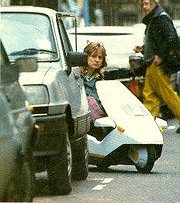| C5
Sinclair Vehicles, 1985
Possibly Sinclair's most famous
product (albeit for quite the wrong reasons), the ill-conceived
C5 "electric car" proved to be the point
at which Sinclair Research's wheels finally fell off. Attracting
controversy and derision in equal measure, the C5 fiasco ended
up having a catastrophic effect on Sinclair's finances. Losses
of up to £7 million eventually forced the company to
sell its computer business to Amstrad.
The C5 was promoted by Sinclair
as a revolutionary advance in personal transport with the
potential to replace the car. The original intention was that
it would be only the first in a whole series of electric vehicles
- it would have been followed the never-released C10 and C15,
each successively bigger and looking more like conventional
vehicles. At only £399, the C5 was a fraction of the
price of a conventional car. In fact, it was not a car at
all but was instead a glorified electric tricycle, powered
by an electric battery with a supplementary pedal drive. It
did not inspire confidence that the C5 was assembled and serviced
by Hoover, better known for its washing machines, which led
to unkind comparisons being made between the two product lines.
 The
machine had several major flaws which doomed it before it
had even been launched. It was capable of only 15 mph (a deliberate
design decision, as electric vehicles which could travel faster
than that required a licence to use). It had a very limited
range which varied according to weather conditions - as little
as 10km in cold weather - and its weight made it a struggle
to pedal. Its cockpit was exposed to the elements (a real
problem in the British climate) and the C5 itself was worryingly
vulnerable in traffic. In a country with dedicated bicycle
paths, such as the Netherlands, this would have been much
less of a problem, but crowded British roads were a very different
environment. This, probably more than anything else, sank
the C5, not least because Sinclair initially did not publicly
acknowledge the problem: The
machine had several major flaws which doomed it before it
had even been launched. It was capable of only 15 mph (a deliberate
design decision, as electric vehicles which could travel faster
than that required a licence to use). It had a very limited
range which varied according to weather conditions - as little
as 10km in cold weather - and its weight made it a struggle
to pedal. Its cockpit was exposed to the elements (a real
problem in the British climate) and the C5 itself was worryingly
vulnerable in traffic. In a country with dedicated bicycle
paths, such as the Netherlands, this would have been much
less of a problem, but crowded British roads were a very different
environment. This, probably more than anything else, sank
the C5, not least because Sinclair initially did not publicly
acknowledge the problem:
I would not want
to drive a C5 in any traffic at all. My head was on a level
with the top of a juggernaut's tyres, the exhaust fumes
blasted into my face. Even with the minuscule front and
rear lights on, I could not feel confident that a lorry
driver so high above the ground would see me. Small wonder
that one of the accessories listed in the C5 brochure is
a high and bright-red reflecting mast, said by the Royal
Society for the Prevention of Accidents [RoSPA] to be a
'must'.
(Daily Telegraph,
11 January 1985.)
The "hi-vis mast"
initially had to be purchased separately, but public pressure
by the RoSPA and media eventually forced Sinclair to include
it in the C5 package. By then, though, the damage had been
done and even then it failed to satisfy everyone. The safety
aspect so worried the authorities in the Netherlands, the
most cyclist-friendly country in Europe, that the C5 was banned
outright. Fewer than 17,000 C5s were sold, mostly in Britain
although a few made it to continental Europe and the United
States, and production was halted after only a few months.
Some were reputedly bought by shipping companies to ferry
deckhands around the huge foredecks of oil tankers.
C5s are now highly sought-after
collector's items and now sell for up to £900, although
£300-£400 is a more likely value. One British
stuntman has even turbocharged a C5 to 70mph (!) and races
it through tunnels of fire. Sir Clive Sinclair would no doubt
have known what that felt like in the wake of the C5's hostile
reception.
See also http://dmoz.org/Science/Technology/Energy/Transportation/Electric_Vehicles/Sinclair_C5
for other websites on the Sinclair C5.

Back
to top
© Chris Owen 1994-2003
|